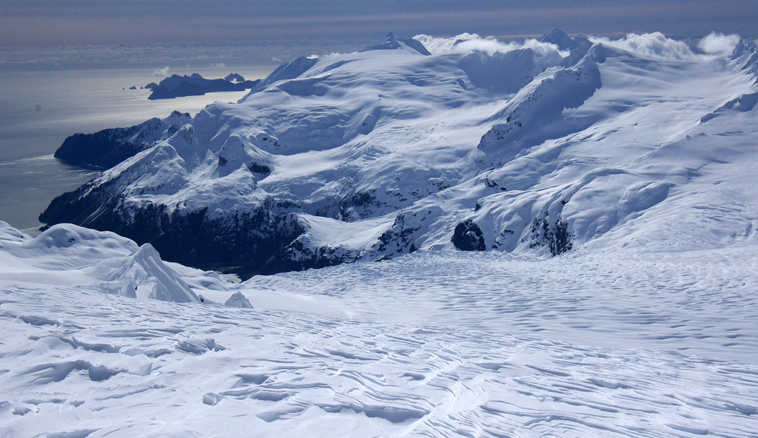ANCHORAGE — By their third day in a tiny snow cave under 4 feet of snow, Chris Hanna and Jenny Neyman thought the shelter in an Alaska ice field might turn into a tomb.
The 7-by-5 space Hanna dug started with a ceiling 40 inches high. Warmth and humidity from their bodies made the ceiling sag to within 8 inches of their faces, like a giant, suffocating sponge. Besides hypothermia, hunger and a shortage of oxygen, the experienced outdoor enthusiasts had to stave off claustrophobia.
“The closer that ceiling got, the more unnerving it was,” Neyman said Wednesday.
Luckily, their ordeal ended a few hours later. A locator beacon led an Alaska Air National Guard helicopter to the underground shelter, and the crew swooped in and dug out the pair after four nights on Harding Ice Field, including three in the cave.
Neyman, 36, and Hanna, 46, had planned to spend April 8 cross-country skiing on the 700-square-mile ice field, which offers spectacular views of peaks, fjords and ocean.
A friend flew them there under blue skies in the morning and planned to return at 5 p.m., long before a storm expected that night. By 2 p.m., the clouds moved in. By 3 p.m., they knew the plane couldn’t reach them.
They said their first inclination was to ski down one of the ice field’s 30 glaciers. But by nightfall, with visibility at 10 feet, Neyman said she could not go on. They spent the night in their tent.
The predicted blizzard hit the next afternoon, with snow flattening the tent.
“We were being buried alive,” Hanna said.
Almost as quickly as he could scoop snow off, it poured around the tent like liquid. Exhausted, Hanna climbed inside and sent text messages to his 18- and 22-year-old daughters. He said he loved them and was proud to be their dad.
He told Neyman that without a shovel to dig a snow cave, their odds of survival were not good.
“She was not happy with my report,” Hanna said. “She said, ‘No, we have to do something.’”
They talked for 20 minutes with limbs splayed on the tent walls to keep it from collapsing. Hanna decided to try digging a snow cave — or die trying.
“If death is for sure what’s going to happen, you won’t lose anything by trying,” Neyman said.
With his hands and a ski, Hanna dug down outside at a 45-degree angle. He created a 7-foot, 30-inch-diameter tunnel, then dug horizontally to create the snow cave. They scrambled inside with sleeping bags, pads, a stove and food.
Within minutes, snow filled the entrance. Silence replaced the sound of the tent flapping in 40 mph wind.
Hanna was soaked. It took hours to control his shaking.
They could send and receive messages by their locator beacon if it was paired with a phone, but the phone’s battery was quickly losing life.
All they could do was wait. Hanna used a broken tent pole to make an air hole. When he made it too large, it let in too much cold air, and the shaking returned.
They briefly lit their stove, but the fumes made them cough and it wouldn’t stay lit. Hanna was so dehydrated, his throat swelled when he tried eating freeze-dried turkey tetrazzini reconstituted with slushy water.
Still, they had hope. A text message told them Air Guard skiers were on their way.
Early April 12, they heard a helicopter fly by. Hanna tied an orange space blanket to the tent pole and jammed it through the air hole as a signal.
A few hours later, they heard a helicopter, then snowshoes crunching on snow. Someone pulled on the space blanket on the pole.
“It was like ice fishing in reverse,” Hanna said.
A voice called out, wondering where to dig. Fifteen minutes later, the Air Guardsman had Hanna and Neyman out of their collapsing cave.
At a hospital, staff checked Neyman’s vital signs and bought her and Hanna lunch in the cafeteria. Hanna declined treatment but saw his daughters.
“When you think the end is probable or inevitable, that’s what you think about,” he said.

